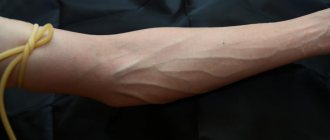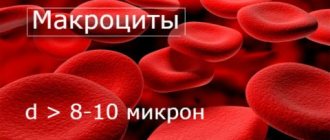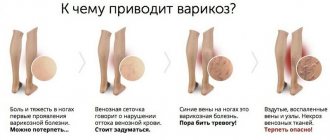Reasons for appearance
Under the skin there are capillaries (vessels), the walls of which are elastic and perfectly narrow or expand under blood pressure. With rosacea, the capillaries expand, but cannot narrow, so they appear under the skin. There are many reasons for the appearance of this defect on the face:
- if your mother or grandmother developed a capillary network at a certain age, then you are at risk;
- region of residence, because residents of northern countries are more susceptible to rosacea than people from countries with a temperate continental climate;
- bad habits that increase blood pressure and cause vasospasm;
- nervous tension, as well as depression, insomnia, difficult work and even family problems;
- different types of diseases: malfunctions of the liver, cardiovascular system and thyroid gland lead to the appearance of a vascular network on the face;
- improper care and nutrition, UV rays.
Important! Cuperosis is a cosmetic defect, but it can cause premature aging of the facial skin. If at least one capillary has burst, then try to get a consultation with a cosmetologist as soon as possible.
Reasons for the appearance of the capillary network
Men do not pay too much attention to their legs, which cannot be said about women: they tend to flaunt their beautiful legs, and they take care of this part of the body no less than, say, their hands.
But the fact that blue or red capillaries appear on the legs in women more often than in men is not explained by a lack of foot care (or excessive enthusiasm for this activity), but by other, more objective reasons.
First of all, hormonal imbalance, which is characteristic of the period of gestation and childbirth: this is the most common cause of this pathology. Other factors leading to an increase in the number of superficial vessels include the following:
- venous insufficiency;
- thrombocytopenia, the consequence of which is increased fragility of blood vessels;
- hypoxia;
- influence of ultraviolet radiation;
- exposure to low temperatures;
- osteochondrosis;
- genetic predisposition.
Secondary factors include physical inactivity, a large amount of time spent standing, frequent exposure to stressful situations, and unbalanced nutrition.
When the capillary network begins to collapse, this is a clear signal sent by the body. It indicates the beginning of irreversible processes occurring in blood vessels with localization in the surface layer of the skin (epidermis). Of course, such processes can also be observed on other parts of the body - face, back, arms.
You need to start treating the symptoms of capillaries in the legs as early as possible, without waiting until they begin to burst, which usually causes circulatory failure in the lower extremities with all the ensuing consequences.
The most common causes of overstretching and rupture of small superficial blood vessels located in the legs are circulatory problems, aggravated by the fact that the outflow of venous blood into the heart is carried out against the force of gravity. So if you are used to sitting cross-legged, remember that this can cause capillary netting.
The appearance of rosacea (small red or blue streaks) on the legs is often provoked by age-related changes in the body, alcohol abuse and smoking, excessive and constant physical activity.
What to do if capillaries burst?
If red networks of blood vessels appear on your face, you can resort to professional and home cosmetic procedures to remove them. It is also worth remembering the rules for caring for skin on which vascular networks have already appeared:
1. Refuse aggressive care, excluding scrubs with large abrasive particles, fruit peeling, natural or artificial tanning.
2. Visit a dermatologist or cosmetologist to help you choose skin care products. The most effective products are those that contain calendula.
3. Ask a specialist to recommend medications for rosacea. Today, in order to remove the unsympathetic manifestations of this disease, tablets and capsules containing ascorbic acid and rutoside (“Ascorutin”) are used.
4. Be sure to strengthen blood vessels by practicing contrast showers, light massage and gentle care.
Symptoms of the disease
Broken capillaries under the skin on the face manifest themselves immediately. A person will not feel pain, but the following manifestations are possible:
- Reddish spots appear on the skin , which turn white when pressed with a finger.
- , pink cobwebs form on the face, arms and legs .
- In the sun or in the heat, the skin on the face turns red and spots appear.
Note! The skin of a person susceptible to rosacea differs little from healthy skin. The pathology occurs both in thin, white, dry skin and in people with increased facial fat.
When the first symptoms appear, you should consult a doctor. Only an experienced dermatologist will be able to distinguish capillary meshwork from moles or bruises. Which are mistaken for rosacea.
Removing capillaries at home
Professional treatment and removal are effective, but quite expensive. Also, these procedures should not be attended during pregnancy and lactation, but it is at this time that the skin is most susceptible to rosacea. And if you can’t go to a cosmetologist yet, then try removing capillaries with folk remedies.
Mask made from Ascorutin tablets and green tea
This mask is best done after washing your face in the evening before going to bed, using the following recipe:
- add 2 crushed Ascorutin tablets to 50-100 ml of green tea;
- add white clay to the composition.
- Apply the resulting mask to your face for about 20 minutes. The procedure should be repeated 2-3 times a week, alternating it with massage.
Oat flour
For this product you will need 1 tbsp. l. oatmeal and the same amount of chopped chamomile, rosemary or cypress. Dry raw materials must be filled with 1-2 tbsp. l. oils, mix and apply to face. The duration of the procedure is 15 minutes.
Oil based mask
For this remedy, take 1 tbsp. l. milk thistle or calendula oils, then add 2-3 drops of mint, lemon or lavender essential oil. Warm the mixture and rub into the skin during a massage. This nourishing composition does not need to be washed off, and if you decide to wash your face, be sure to use a nourishing or healing cream.
How to remove capillaries on the face using starch?
Starch effectively treats broken capillaries, so you should definitely use it for home treatment. For example, a mask made from grated potatoes, which should be applied to the skin for 15 minutes, helps well against dilated blood vessels. A product based on dry starch is also effective:
- several fresh sea buckthorn berries, strawberries and raspberries should be crushed with a fork;
- to the berries you need to add 1 tbsp. l. starch and mix the product again;
- Leave the composition on the skin for a quarter of an hour.
After the procedure, wipe your face with a weak chamomile decoction, which will moisturize the skin and cleanse it.
Advice! Take 100 ml of a weak chamomile decoction and add 2-3 tbsp. l. potato starch. The mask should be left on the skin for at least 15 minutes.
Broken capillaries: symptoms and diagnosis
Broken capillaries are easily visible on your skin. Symptoms include:
- Thin, thread-like lines
- A web-like network of red lines
- May be reddish, purple or bluish
- May cause itching and pain
- Measurements between 1-3mm
- Commonly found on the chin, nose, cheeks
Red thread-like patterns on the surface of the skin make this condition easy to diagnose. However, doctors may also perform clinical tests to determine if any underlying health condition is causing the broken capillaries. They can carry out the following tests:
- CT scan
- MRI
- X-rays
- Liver function tests
- Analyzes
We recommend reading
How to Get Rid of Oily Skin: 9 Effective Home Remedies and Prevention Tips
They may also carry out other relevant tests to identify any abnormalities. Depending on the diagnosis, they will treat your condition.
Nutritional Features
You should definitely pay attention to the basics of proper nutrition! The following products provoke an exacerbation of this cosmetic defect:
- sweet drinks, especially coffee, lemonade and strong tea;
- dishes with a lot of salt, hot spices;
- hot and fatty sauces;
- all types of sweets and drinks that contain chocolate.
At the same time, it is worth enriching the diet with different types of cereals, fresh vegetables and fruits, which contain fiber and microelements. Also useful are all types of boiled meat and fish, which are an invaluable source of protein and Omega-3 fatty acid.
Advice! During treatment, it is important to take multivitamins and eat foods containing vitamins A, B, C, PP and K, which increase elasticity and strengthen blood vessels.
How to train your blood vessels yourself at home?
If you want to increase the tone of your vascular walls, as well as restore elasticity, it is not at all necessary to seek help from a clinic. You can train weak veins yourself at home. To do this, you just need to adhere to the following recommendations from doctors:
- Use of medications. The drug “Ascorutin” is very capable of taking care of blood vessels. In addition, this medication has virtually no contraindications for use.
- Use of external means. Ointments and gels from the pharmacy, for example, Troxevasin, Lyoton, can act locally on all problem areas.
- Using traditional medicine recipes. Experts strongly recommend using decoctions and tinctures based on medicinal plants, and also periodically applying lotions to problem areas. Folk remedies are very good auxiliary methods of treating capillaries and blood vessels.
- Taking vitamin complexes. To strengthen blood vessels, the patient needs to take vitamins A, K, D, E, as well as group B, in particular B6, B1, B12. They can be used both in the form of pharmaceuticals and consumed food products enriched with them, for example, legumes, vegetables, fish and fruits.
- Correct diet. Experts recommend limiting your consumption of flour, sweets and baked goods. You should also avoid fatty foods and preservatives. Dietary dishes that are steamed, as well as boiled or baked foods are the main principle of nutrition for those who want to strengthen blood vessels and capillaries.










